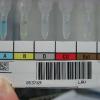Reputation Activity
-
 Dansket got a reaction from David Saikin in VISION ABD GEL CARD NOT REACTIVE WHEN ANTI A1 IS PRESENT
Dansket got a reaction from David Saikin in VISION ABD GEL CARD NOT REACTIVE WHEN ANTI A1 IS PRESENT
Based on an observational study of ABO grouping in Gel I reported at the 1997 AABB Annual Meeting, ABO Plasma Grouping discrepancies occurred in 0.8% (26/3183) adult ABO grouping tests in Gel. Anti-B was not detected in 24/26 patients, anti-A was not detected in 2/26 patients, and anti-A1 was not detected in 3183 patients.
In comparison, anti-A and anti-B was detected in 19/26 patients by the immediate-spin tube test, and was detected in 7/26 patients after 10 minute incubation room temperature incubation and centrifugation.
Based on this study and 20 years of gel testing since that time have shown me the anti-A1 is rarely detected in Gel and that 70-80% of ABO plasma grouping discrepancies are resolved using the immediate-spin tube test.
Centrifugation is used quite differently in gel versus tube testing. Centrifugation is used to separate agglutinated cells from un-agglutinated cells within the gel column, but is used to enhance agglutination in standard tube tests by forcing cells together at the bottom of the tube. This may contribute to the increased sensitivity of tube testing in ABO Plasma grouping tests.
-
 Dansket got a reaction from galvania in Why don't we incubate in DAT testing?
Dansket got a reaction from galvania in Why don't we incubate in DAT testing?
Incubating patient plasma with patient red blood cells and then applying the antiglobulin test is no longer a Direct Antiglobulin Test but an Autocontrol test which is an Indirect Antiglobulin Test. Some may think an Autocontrol test gives the same results as a Direct Antiglobulin Test, but that is not always true.
-
 Dansket got a reaction from ANORRIS in Why don't we incubate in DAT testing?
Dansket got a reaction from ANORRIS in Why don't we incubate in DAT testing?
Incubating patient plasma with patient red blood cells and then applying the antiglobulin test is no longer a Direct Antiglobulin Test but an Autocontrol test which is an Indirect Antiglobulin Test. Some may think an Autocontrol test gives the same results as a Direct Antiglobulin Test, but that is not always true.
-
 Dansket got a reaction from jasmine in VISION ABD GEL CARD NOT REACTIVE WHEN ANTI A1 IS PRESENT
Dansket got a reaction from jasmine in VISION ABD GEL CARD NOT REACTIVE WHEN ANTI A1 IS PRESENT
Based on an observational study of ABO grouping in Gel I reported at the 1997 AABB Annual Meeting, ABO Plasma Grouping discrepancies occurred in 0.8% (26/3183) adult ABO grouping tests in Gel. Anti-B was not detected in 24/26 patients, anti-A was not detected in 2/26 patients, and anti-A1 was not detected in 3183 patients.
In comparison, anti-A and anti-B was detected in 19/26 patients by the immediate-spin tube test, and was detected in 7/26 patients after 10 minute incubation room temperature incubation and centrifugation.
Based on this study and 20 years of gel testing since that time have shown me the anti-A1 is rarely detected in Gel and that 70-80% of ABO plasma grouping discrepancies are resolved using the immediate-spin tube test.
Centrifugation is used quite differently in gel versus tube testing. Centrifugation is used to separate agglutinated cells from un-agglutinated cells within the gel column, but is used to enhance agglutination in standard tube tests by forcing cells together at the bottom of the tube. This may contribute to the increased sensitivity of tube testing in ABO Plasma grouping tests.
-
 Dansket got a reaction from jojo808 in inconclusive antibody ID
Dansket got a reaction from jojo808 in inconclusive antibody ID
JoJo808,
Which test method is used for routine testing at your facility? Were the "suspicious results" only observable by microscope? Were the night tech's "suspicious test results" reproducible?
Based on my routine testing protocol and detailed protocols for investigating "positive" antibody screens (that includes criteria for referring samples to a reference laboratory), I would not flag a patient with a history of "inconclusive antibody identification" for antiglobulin-crossmatching-in-perpetuity when subsequent antibody screens are negative.
It all depends on how well you feel your test system performs. If I didn't have a tightly controlled system, I might choose to require routine antiglobulin crossmatches in perpetuity for patients with a single positive antibody screen attributed to an "inconclusive antibody identification".
-
 Dansket reacted to galvania in Direct antiglobulin test
Dansket reacted to galvania in Direct antiglobulin test
And never EVER , under ANY circumstances look at gel tests under a microscope or a magnifying glass - unless you want to call absolutely everything positive and waste everybody's time
-
 Dansket reacted to galvania in Questionable blood types
Dansket reacted to galvania in Questionable blood types
Except that we are talking about patients here that have anti-B in their own plasma already. We are not talking about patients who have no detectable anti-B in their plasma. So we are talking about a patient who groups as an A in the forward group and has a ++ reaction in B cells, due to anti-B. So if he receives group A plasma, yes, he will receive some anti-B - which will be diluted out by his own plasma which already contains anti-B………..
Realistically, I think it is a question of comparing risks, benefits and the amount of work.
In this case, what are the chances that this is an ABwk patient? - Very low
What is the risk, if this patient is an ABwk, of transfusing this patient with group A blood? None. On the contrary it is better than transfusing with group AB
What is the risk, if this patient is an ABwk, of transfusing this patient with group A plasma? very little as the patient already has a considerable amount of his own anti-B in his plasma
What is the risk, if this donor is an ABwk, of transfusing to a group A patient? Very little as the amount of B antigen present is so small
How much work do you need to do to be 100% sure that this type of reaction belongs to a patient who is really a group A and not ABwk? As an absolute minimum genotyping, possibly complete sequencing. Long delays and $$$$$$$$$$$$$$$.
-
 Dansket reacted to galvania in Questionable blood types
Dansket reacted to galvania in Questionable blood types
I would just like to add another comment to this discussion. CAT is NOT the best method for looking for weak ABO antigens or antibodies.
-
 Dansket reacted to galvania in Questionable blood types
Dansket reacted to galvania in Questionable blood types
Yes, that's true, Malcolm. On the other hand, if you test with 2 different monoclonal anti-A reagents (and an anti-AB for good measure - a real one not an A+B) and they all come up 4+, I think it's fairly safe to say that the patient is a group A. I think that giving group O blood in this case is both wasteful of group O blood (unless you are swimming in it) and overkill
-
 Dansket got a reaction from dcubed in anti-Lewis a,b
Dansket got a reaction from dcubed in anti-Lewis a,b
If current antibody screen is positive and Lewis antibody identified, do immediate-spin and anti-igG crossmatches, issue crossmatch-compatible random donor units. If current antibody screen is negative and there is a history of Lewis antibody, do Computer Crossmatch with random donor units.
-
 Dansket got a reaction from albaugh in anti-Lewis a,b
Dansket got a reaction from albaugh in anti-Lewis a,b
If current antibody screen is positive and Lewis antibody identified, do immediate-spin and anti-igG crossmatches, issue crossmatch-compatible random donor units. If current antibody screen is negative and there is a history of Lewis antibody, do Computer Crossmatch with random donor units.
-
 Dansket got a reaction from Yanxia in anti-Lewis a,b
Dansket got a reaction from Yanxia in anti-Lewis a,b
If current antibody screen is positive and Lewis antibody identified, do immediate-spin and anti-igG crossmatches, issue crossmatch-compatible random donor units. If current antibody screen is negative and there is a history of Lewis antibody, do Computer Crossmatch with random donor units.
-
 Dansket got a reaction from Marilyn Plett in anti-Lewis a,b
Dansket got a reaction from Marilyn Plett in anti-Lewis a,b
If current antibody screen is positive and Lewis antibody identified, do immediate-spin and anti-igG crossmatches, issue crossmatch-compatible random donor units. If current antibody screen is negative and there is a history of Lewis antibody, do Computer Crossmatch with random donor units.
-
 Dansket got a reaction from AuntiS in anti-Lewis a,b
Dansket got a reaction from AuntiS in anti-Lewis a,b
If current antibody screen is positive and Lewis antibody identified, do immediate-spin and anti-igG crossmatches, issue crossmatch-compatible random donor units. If current antibody screen is negative and there is a history of Lewis antibody, do Computer Crossmatch with random donor units.
-
 Dansket reacted to Gkloc in Stat Centrifuge
Dansket reacted to Gkloc in Stat Centrifuge
We use the STAT Spin Express 4 here which allows us to centrifuge our specimens for 3 minutes.
-
 Dansket got a reaction from exlimey in Rh Pos or Rh Neg?
Dansket got a reaction from exlimey in Rh Pos or Rh Neg?
I call them weakly-reactive, while antibody screens that are 3+ to 4+ are termed strongly-reactive. Either way, they are documented in the computer as "Positive". In my experience (20+ years with gel), the majority of positive antibody screens detected in gel were weakly-reactive.
As trained observers, we expect to see strong agglutination (3+ or 4+) when performing Rh(D) typing with anti-D reagent antisera. Weak agglutination (<3+) is unexpected and should be investigated. Judd's paper provided statistical evidence for interpreting weakly-reactive test results with gel anti-D.
ORTHO's current IFU (version 3.0) classifies any positive test result (regardless of strength) with gel anti-D as Rh Positive (assuming a negative control test). Judd's paper is not cited in the IFU's Bibliography.
Interpreting weakly-reactive test results with gel anti-D as 'Rh Negative' contradicts ORTHO's FDA approved IFU.
-
 Dansket got a reaction from NicolePCanada in ABO Retype
Dansket got a reaction from NicolePCanada in ABO Retype
To address this question of safety, I would like to see hard data from the AABB community as to the frequency of events where an ABO discrepancy was detected in the second ABO determination that was not detected in the first ABO determination. More importantly, did the detection of an ABO discrepancy (missed by the first ABO determination) prevent the transfusion of ABO incompatible red blood cells?
My responses above assume that the ABO discrepancy was demonstrable by repeat testing of the first blood sample.
-
 Dansket got a reaction from Ensis01 in Antibody I.D. Work-ups
Dansket got a reaction from Ensis01 in Antibody I.D. Work-ups
You didn't say how large your laboratory is and how Transfusion Services is staffed on the night shift.
When I was doing manual testing, it was consistent with your new supervisor's approach. An autocontrol was only run with the first panel only.
With automated gel testing on ProVue, only full panels can be run. Rule-outs are done by entering panel test results into the AntigenPlus antibody identification software. A maximum of 3 panels would be run before sending specimen to reference lab.
This standardized protocol was used in a small hospital transfusion service (<1000 rbcs transfused annually) staffed with generalists. This protocol was easily followed, even with only 1 generalist on staff at night for the entire laboratory.
-
 Dansket got a reaction from Malcolm Needs in BloodBankTalk: Allergic Reaction
Dansket got a reaction from Malcolm Needs in BloodBankTalk: Allergic Reaction
I just answered this question.
My Score PASS
-
 Dansket got a reaction from Malcolm Needs in BloodBankTalk: Antibody/Antigen Reaction
Dansket got a reaction from Malcolm Needs in BloodBankTalk: Antibody/Antigen Reaction
I just answered this question.
My Score PASS
-
 Dansket reacted to Malcolm Needs in Weak D testing in the presence of a positive DAT?
Dansket reacted to Malcolm Needs in Weak D testing in the presence of a positive DAT?
No Mabel. I wouldn't have any concerns whatsoever.
-
 Dansket got a reaction from Cliff in 2 cell verses 3 cell screen
Dansket got a reaction from Cliff in 2 cell verses 3 cell screen
I've been using Gel for all routine testing since 1995 and ProVue since 2004-5.
All our specimens (EDTA) are initially centrifuged for 3 minutes in a Stat Spin Express centrifuge. You should use only platelet-poor plasma when testing in Gel. Standard laboratory centrifugation does not give you platelet-poor plasma.
Part of our standard routine for resolving ABO Plasma Grouping discrepancies and weakly positive antibody screens is to centrifuge the specimen three (3) more times for a total of 9 minutes of high-speed centrifugation and retest in Gel. This will reduce but not entirely eliminate the "sprinkles".
To me, "sprinkles" in Gel correspond to the "sticky cells" seen in microscopic reading of standard tube tests. I don't think "sprinkles" are clinically significant. We standardized reading of gel cards using lighted 35mm photographic slide viewer. This viewer has the milky plastic background see in X-Ray viewers and that is used by ProVue.
-
 Dansket got a reaction from John C. Staley in 2 cell verses 3 cell screen
Dansket got a reaction from John C. Staley in 2 cell verses 3 cell screen
I don't condemn Standard Tube Testing as much as I abhor the intrinsic variability (increased risk) introduced by workers who were never shown or who never mastered the technique (as practiced by the expert serologists you referenced) to be able to produce consistent results particularly with weak (<=2+ agglutination). Discussions with experts does nothing to address this issue, whereas automated testing completely eliminates the issue of manual (technique-dependent) testing methods.
-
 Dansket got a reaction from John C. Staley in 2 cell verses 3 cell screen
Dansket got a reaction from John C. Staley in 2 cell verses 3 cell screen
These quotes are from page 91 of the 1997 ARC Immunohematology publication, "The inconstant degree of agitation that different workers use in resuspending RBC buttons after centrifugation. This can significantly affect the sensitivity of tube tests and explains many instances of variability seen in the performance of proficiency tests", and "Incorrect technique is the most likely cause of unwanted negative tests. Standardized column technologies, such as the gel test, eliminate many of the variables inherent in test tube methods".
John Judd also published a white paper through ORTHO regarding use 2-cell versus 3-cell antibody screen reagents probably prior to the ARC Immunohematology publication in 1997. In that white paper, he concluded that difference in test results between 2-cell and 3-cell reagents was attributable to variation in technique between personnel performing the tube tests and not due to antibody screen cells reagent.
I believe manual tube testing is the 800lb dinosaur in the room of a 21st century Transfusion Service. The rest of the Clinical Laboratory discontinued manual testing in the 20th century. Automated testing is not just an answer for high volume testing but is critical safety enhancement in even the smallest Transfusion Service.
-
 Dansket got a reaction from Malcolm Needs in 2 cell verses 3 cell screen
Dansket got a reaction from Malcolm Needs in 2 cell verses 3 cell screen
I don't condemn Standard Tube Testing as much as I abhor the intrinsic variability (increased risk) introduced by workers who were never shown or who never mastered the technique (as practiced by the expert serologists you referenced) to be able to produce consistent results particularly with weak (<=2+ agglutination). Discussions with experts does nothing to address this issue, whereas automated testing completely eliminates the issue of manual (technique-dependent) testing methods.










